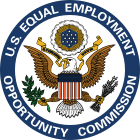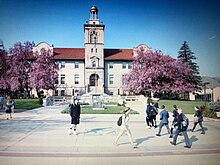 | |
Type of site
| E-government |
|---|---|
| Available in | English Spanish at USA.gov/espanol |
| Website | www |
| Alexa rank | |
| Commercial | No |
| Launched | September 22, 2000 |
| Current status | Online |
Content license
| Public domain |
USA.gov is the official web portal of the United States federal government.
It is designed to improve the public's interaction with the US
government by quickly directing website visitors to the services or
information they are seeking, and by inviting the public to share ideas
to improve government. USA.gov links to every federal agency and to
state, local, and tribal governments, and is the most comprehensive site
in—and about—the US government. While the primary target audience of
USA.gov is the American public, about 25 percent of USA.gov’s visitors
come from outside the United States.
USA.gov is part of the Technology and Transformation Services in the General Services Administration (GSA), and includes the Spanish-language web portal to US government services, USAGOV en Español (formerly GobiernoUSA.gov).
History
USA.gov began in 2000 when Internet entrepreneur Eric Brewer, whose early research in parallel computing was funded by the United States Department of Defense,
offered to donate a powerful search engine to the government. That
donation helped accelerate the government's earlier work to create a
government-wide portal. In June 2000, President Clinton
announced the gift from the Federal Search Foundation, a nonprofit
organization co-founded by Brewer and fellow entrepreneur David Binetti,
and instructed that the portal be launched in 90 days.
FirstGov.gov was launched 87 days later on September 22, 2000, during the first-ever webcast originating from the White House Oval Office.
GSA and 22 Federal agencies funded the initiative in 2001 and 2002.
Since 2002, USA.gov has received an annual appropriation from the U.S. Congress.
The name FirstGov.gov was changed in 2007 to USA.gov, in response to user suggestions and telephone surveys.
On July 2, 2010, USA.gov revamped the website to improve user
access to citizen services through new mobile applications for on-the-go
instant access; public engagement platforms; and the fastest, most
comprehensive search function for government information.
Structure
USA.gov
helps visitors find federal information in several ways, detailed
below. Additionally, USA.gov invites the public to share feedback on
apps they would find useful by using government information available on
Data.gov and USAspending.gov, and to share ideas to improve government through public dialogues and government contests.
E-mail alerts
Visitors
to USA.gov can sign up for free e-mail alerts in both English and
Spanish, to learn about popular government topics and important services
and benefits. The pages' subjects range from benefits, scams, and
fraud, and contacting elected officials to hurricane recovery, travel,
and jobs.
USAGov Contact Center
For
more than 30 years, the contact center has been a source for answers to
questions about consumer problems and government services.
If visitors cannot find the government information they are
looking for online, they can call 1-844-USAGOV1, or get help through a
live web chat service.
USA.gov content
USA.gov
links to diverse, useful, and timely citizen-centered government
information and services that can help website visitors apply for a
government job, register to vote, file their taxes, find government
benefits, reserve a campsite at a national park, prepare for disasters,
shop at government auctions, learn about visiting the United States, or
report an unsafe product, among many other activities.
The site's policy is to link to websites of the federal
government, quasi-government agencies, and those created by public
sector/private sector partnerships; state and local governments; and
recognized Indian tribes. In rare instances, the sites link to websites
that are not government-owned or government-sponsored if these websites
provide government information and/or services in a way that is not
available on an official government website.
Live chat
USA.gov
offers live chat in English and Spanish, where service representatives
can answer website visitors' questions about federal agencies, programs,
benefits, or services.
RSS feeds
USA.gov and USAGov en Español offer RSS feeds to help the public stay up to date on useful government information. Website visitors can sign up for USA.gov RSS feeds, and the USAGov en Español.
Search.USA.gov
USA.gov's search engine
supports transparency of government information by providing access to
government web pages from U.S. federal, state, local, tribal, and
territorial governments. The portal features state-of-the-art navigation
aids and high-interest, agency-produced databases such as frequently
asked questions, government forms, recalls, and government images. Search.USA.gov is also available on its mobile service. In addition, any U.S. government agency can apply through the USA Services Affiliate Program
to install the Search.gov search capability on its own pages, thus
allowing agencies at all levels to provide website searching for their
own users.
Social Media
USA.gov uses Facebook, Twitter, and YouTube
and Instagram to distribute timely official U.S. government information
and emergency information, announce official government events and
observances, share official government photos and videos, and gather
feedback from the public.
URL shortening
A URL shortening service, go.USA.gov, is available to users that have a .gov
email address (only .gov URLs may be submitted for shortening through
this service). The service will generate a random URL following
go.USA.gov/ which redirects the user to the longer .gov URL stored in
the system.
USAGov en Español
A part of USA.gov, USAGov en Español pulls together all of the U.S.
government's Spanish-language websites and makes them easily accessible
to the public in one central location. The site, which was developed by
Spanish speakers, represents an outreach effort to some 43 million
Americans who report speaking Spanish at home.
Although most of the resources shared on USAGov en Español are
federal, the site also links to Spanish-language content provided by
states, the District of Columbia, the Commonwealth of Puerto Rico, and
local government websites.
Web visitors also can search all federal and state web pages for
Spanish content through the site's search engine, call 1-844USAGOV1 for
help in Spanish and English or chat with a representative online.
Spanish-speaking visitors can sign up for e-mail alerts in Spanish to
let them know about important benefits and services. The website also
offers information on the same topic in both English and Spanish by
simply clicking on a toggle button.
Web best practices
USA.gov
actively promotes best practices within the government web manager
community to improve the overall quality of U.S. federal websites as
well as public access to government information.
Federal Web Managers Council
Interagency Committee on Government Information
USA.gov has a leadership role on the Interagency Committee on Government Information (ICGI), formed to meet requirements of the E-Government Act of 2002
(Public Law 107-347, 44 U.S.C. Ch 36). The ICGI drafts recommendations
and shares effective practices for federal government information
access, dissemination, and retention.
Crisis response initiatives
USA.gov is a critical destination for information during national disasters. After the September 11, 2001, attack on the United States,
USA.gov became a major tool for the U.S. government to provide the most
accurate, timely, and comprehensive information, resources, and
government services available during that crisis.
Several years later, in the wake of Hurricane Katrina
in August 2005, USA.gov participated in efforts led by the Department
of Homeland Security and worked with over 20 federal agencies to develop
guidance to communicate response information related to the storm and
its aftermath. Agencies were encouraged to coordinate web information to
avoid duplication and inconsistencies so the public could quickly and
easily find critical information.
Categories identified during Katrina matched information people
would be looking for in "any" disaster, whether natural or man-made. The
federal web community can now re-use a good deal of the content
developed in response to the hurricane crisis, to enable them to be even
better prepared when the next disaster occurs.
Model to other government websites
USA.gov
serves as a model for other government websites and adheres to all
requirements and guidelines for federal websites, including those
established by the E-Government Act of 2002, the U.S. Office of Management and Budget's (OMB) Policies for Federal Public Websites, and Section 508 of the Rehabilitation Act of 1973 regarding website accessibility. The site also follows requirements of the Privacy Act, the Federal Information Security Management Act, and other privacy and security requirements.
Awards
USA.gov has won numerous awards and media endorsements, including:
- Listing among the "Best of..." by Money Magazine, "Favorite Places on the Web" by the Chicago Sun Times, "Hot Sites" by USATODAY.com, "Top 100 Classic Sites" by PC Magazine, and Time Magazine's 2007 "Top 25 Sites We Can't Live Without."
- It also has won "#1 Federal Government Website—Comparing Technology Innovation in the Private and Public Sectors," by the Brookings Institution; "#1 in Global E-Government Readiness" in the United Nations' Global E-Government Readiness Report 2005; "#1 in Overall Federal e-Government" by Brown University's Taubman Center for Public Policy; and the "Innovations in American Government Award" by Harvard University's Kennedy School of Government.
USAGov en Español was named a finalist for the Arroba de oro, ("the golden @"), has won the Web Content Managers' "Best Practices" award, and consistently scores among the highest in government or private sectors in the American Customer Satisfaction Index.





